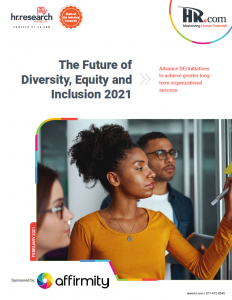What are the best practices proven to most consistently correlate with DE&I success? Backed by data explored in the recent Affirmity-sponsored, HR Research Institute study, ‘The Future of Diversity, Equity, and Inclusion 2021’ study, this blog post looks at 11 diversity, equity, and inclusion practices in use at the organizations with the most effective initiatives.
The Future of Diversity, Equity, and Inclusion 2021 report separates high and low performing organizations via the following criteria:
- DE&I high performers: Respondents who rate their organization’s DE&I initiatives as effective (that is, an 8, 9, or 10 on a 10-point effectiveness scale).
- DE&I low performers: Respondents who rate their organization’s DE&I initiatives as relatively ineffective (that is, a 1, 2, 3, or 4 on a 10-point effectiveness scale).
Of course, correlation is not the same as causation. While we cannot state that any particular practice will definitely lead to success in managing diversity, equity, and inclusion, the following findings would certainly be a good starting point for any organization examining the potential of its current program.
Finding 1: High Performers Tend to Have Support From the Top
DE&I low performers experience more barriers to increasing the effectiveness of DE&I initiatives. On the other hand, DE&I high performers tend to have leaders that prioritize DE&I.
About a quarter of high performers (26%) cite insufficient prioritization at top leadership levels, compared with 52% among DE&I low performers. Because low performers have less support from the top, it’s likely they also lack a leader to oversee and champion initiatives.
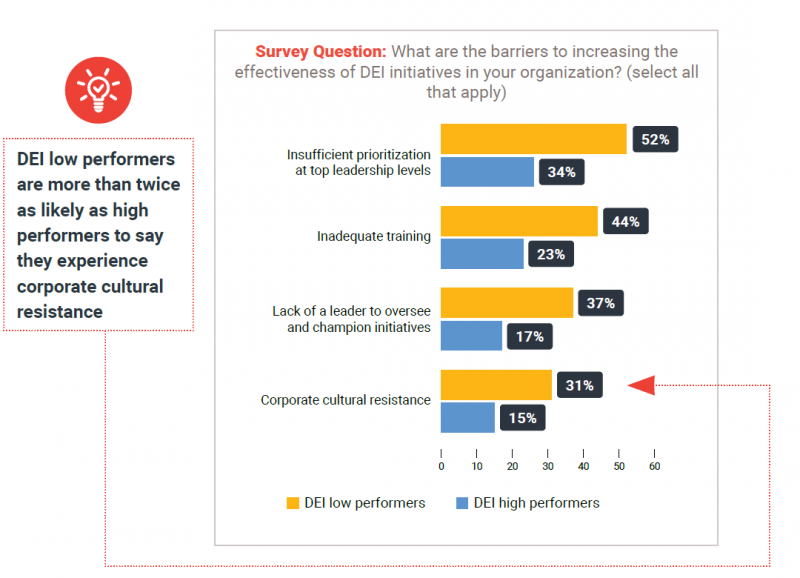
Finding 2: High Performers More Often Have Leaders Who’re Primarily Responsible for DE&I
Although both cohorts say that HR is most likely to be primarily responsible for DE&I, DE&I high performers are twice as likely as low performers to say the CEO/president is primarily responsible (20% vs. 10%).
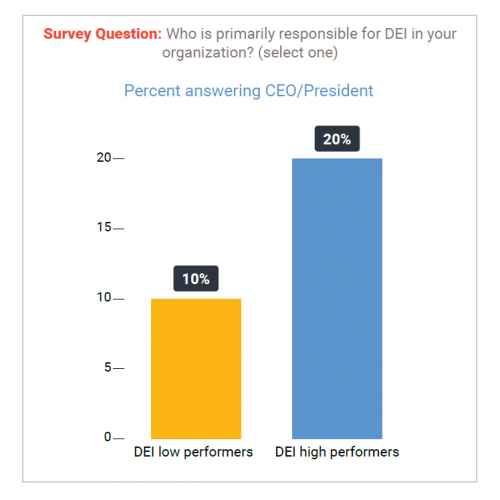
MORE ON HAVING SUPPORT FROM THE TOP | ‘The Undeniable Value of Inclusive Leadership and Visible Equity’
Finding 3: Low Performers Focus Less on Individual Differences
DE&I high performers are more likely than their lower-performing counterparts to consider and track a wider range of characteristics associated with DE&I. The most significant gaps are within the categories of career aspirations (41% vs. 12%) and mental health (37% vs. 7%). High performers are also more cognizant of other individual differences such as diverse living arrangements, thinking style, sexual orientation, gender identity, and educational background.
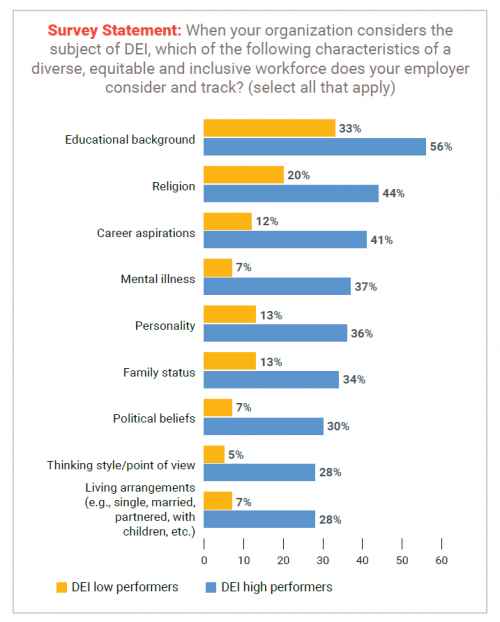
Finding 4: High Performers Incorporate DE&I Into Their Strategic Plans and Business Objectives More Often
DE&I high performers more often agree or strongly agree (93%) that DE&I plays a role in strategic planning, compared with just 34% of DE&I low performers. High performers are also more likely to agree or strongly agree (92%) that this strategic framework is formally integrated into their business strategies, compared with low performers (20%).
Furthermore, high performers (92%) are also more likely than low performers (25%) to agree that DE&I initiatives are quite visible to their workforce. Visibility brings forth transparency and helps to create and sustain a culture of trust.
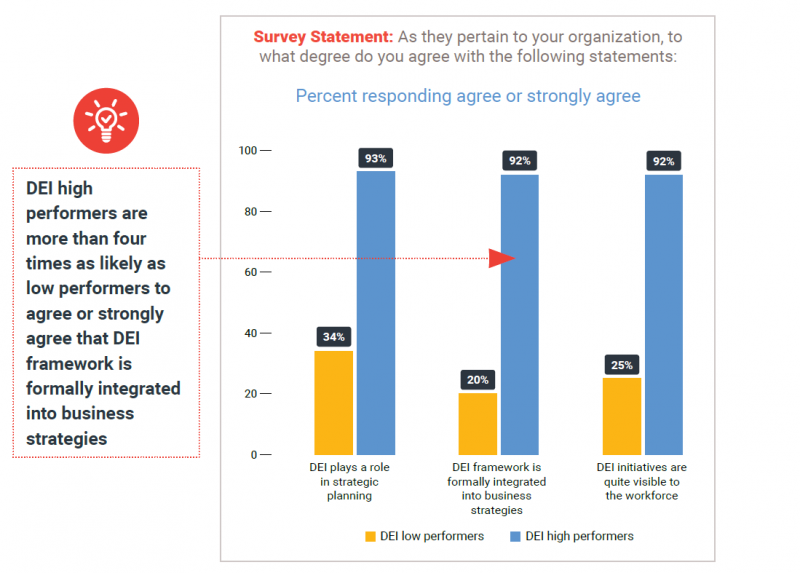
Finding 5: High Performers Are Much More Likely to Communicate the Importance of DE&I Throughout the Organization
DE&I high performers are far more likely than low performers to consistently communicate the importance of DE&I throughout the organization to a high or very high extent (79% vs. 7%). High performers are also much more likely to stress DE&I in other parts of the talent management process, including the talent acquisition and succession management process.
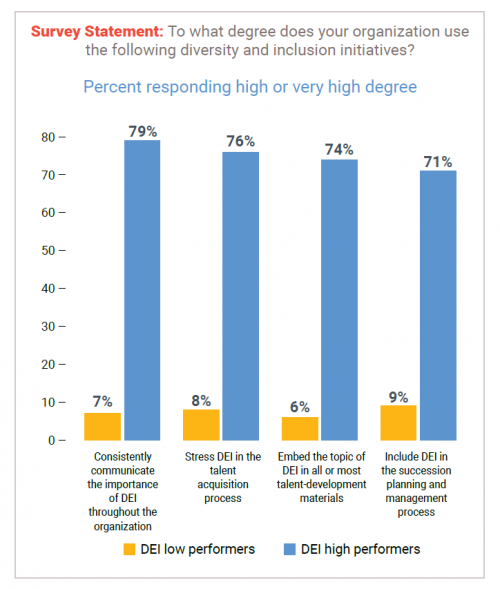
Finding 6: High Performers Tend to Use More Advanced Metrics and Set More Goals
DE&I high performers are much more likely than low performers to use a variety of metrics and analytics to gauge the current state of DE&I in their organization. This is especially true in regard to advanced workforce demographics, diversity goals related to succession planning, diversity goals among teams/departments, and engagement levels.

YOU MIGHT ALSO LIKE | ‘Do You Know Your Diversity Numbers? The Value of Intersectionality, Benchmarking, and Beyond’
Finding 7: High Performers Are Much More Likely to Offer DE&I-Related Training Programs
DE&I high performers (51%) are more than seven times as likely as DE&I low performers (7%) to provide pay equity training. High performers are also more likely to invest in training in other key DE&I areas such as communication practices training, anti-racism training, and inclusion awareness training.

Finding 8: High Performers Are Much More Likely to Have Initiatives That Improve DE&I in the Leadership Ranks
Most DE&I high performers (88%) have one or more leadership development initiatives focused on improving DE&I in leadership. By comparison, just 33% of low performers do. Such programs have the potential to help women and other underrepresented groups overcome the cultural and organizational challenges that sometimes hinder them in their aspirations to become leaders.
Having a diverse set of leaders at the top is an important step in bringing broader diversity throughout the organization. Perhaps because of this, DE&I high performers are more likely to mandate diversity in leadership and include incentives.
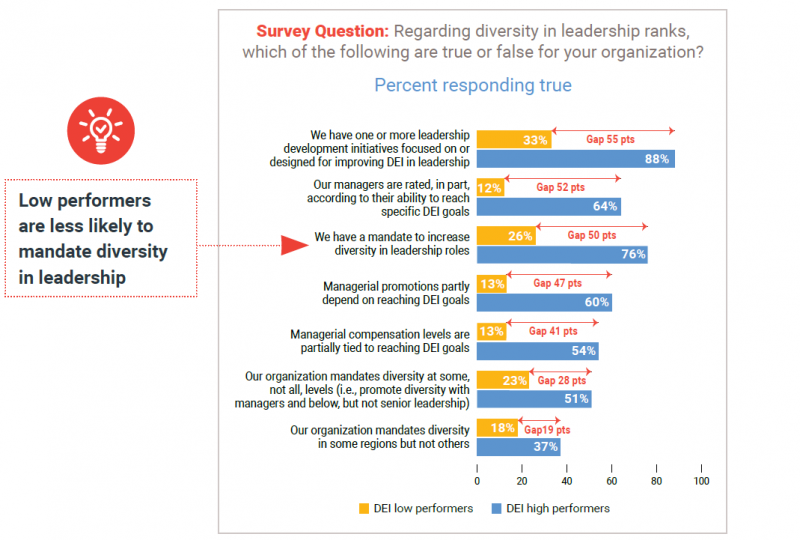
Finding 9: High Performers Provide More Inclusive Benefits
More DE&I high performers (64%) than DE&I low performers (29%) ensure that healthcare and Employee Assistance Program (EAP) providers reflect the gender, race/ethnicity, and language spoken of the workforce. For example, ensuring that employees who don’t speak the dominant language of the workforce are still able to get the same level of healthcare and EAP support as those who do.
DE&I high performers overall provide more inclusive benefits, but it’s important to note that offering such benefits is just one part of the equation. A culture that supports their use is also essential. If employees fear there could be negative implications for their careers or pay, they could be less likely to use them. Or, they may potentially use them knowing that they would be passed over for a promotion or raise and ultimately consider leaving the organization for an organization with better work-life balance.
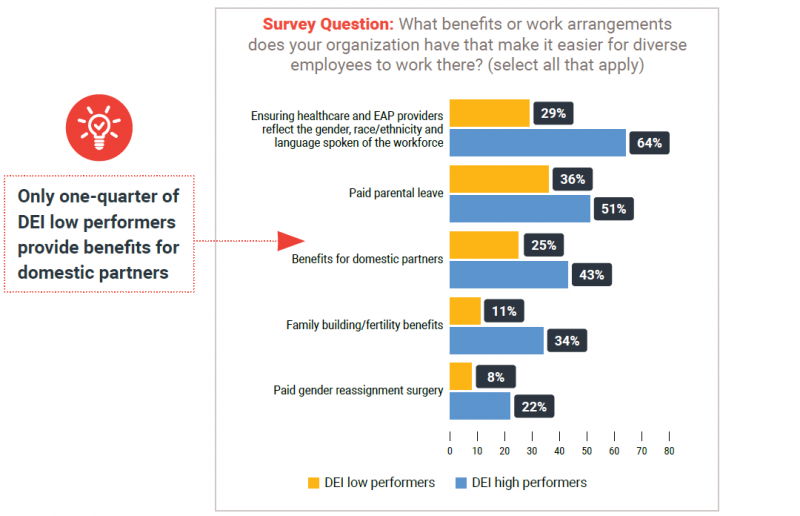
Finding 10: High Performers Prioritize Equal Pay and Often Have a Formal Budget for Closing Pay Gaps
The large majority of DE&I high performers agree or strongly agree (85%) pay is equitable in their organization. In contrast, just 40% of DE&I low performers say the same.
DE&I high performers are also more than four times (82%) as likely as DE&I low performers (18%) to say that regarding executives in their organization, equitable pay is among the top five priorities. More than half of high performers (56%) indicate they have a formal budget for closing pay gaps, considerably more than low performers (11%). This may be because low performers lack more support from the top.
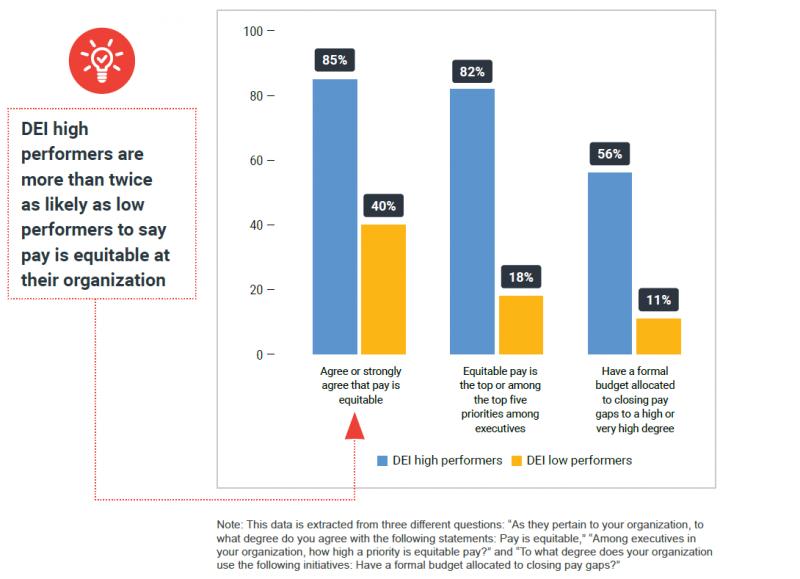
RELATED READING ON PAY EQUITY | ‘How to Connect Your Pay Reporting Requirements to Your Pay Equity Efforts’
Finding 11: High Performers Are More Than 5x as Likely as Low Performers to Use Regression Analysis to Measure Pay Gaps and Pay Equity
DE&I high performers scrutinize performance pay more than low performers. This may be, in part, because high performers get more support from the top to measure DE&I as well as adequate budgets to rectify potential pay inequity.
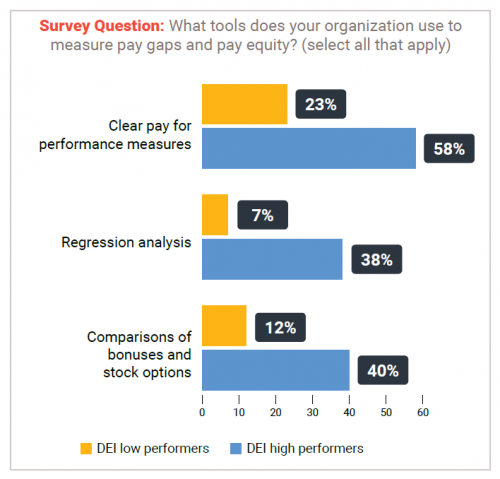
The Future of Diversity, Equity and Inclusion 2021: Continue Reading
These 11 findings are just a sample of the 30+ points of close analysis in the full report. Grab a copy of the white paper and discover:
- The current state of play in DE&I, as companies struggle to mature their programs
- The revealing extent to which organizations believe their current demographics reflect the overall marketplace
- More insights into pay gaps, pay equity, how DE&I training is typically rolled out, and much more
Download your copy of the white paper today.
